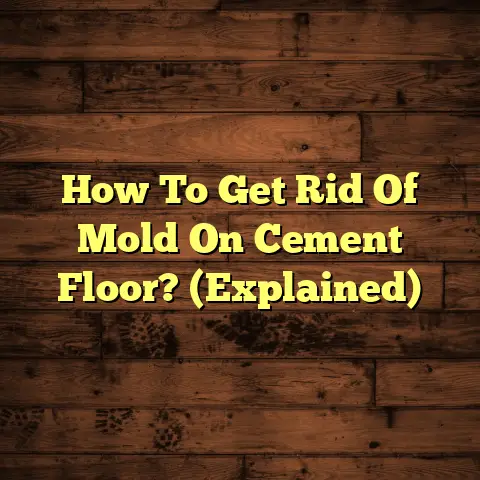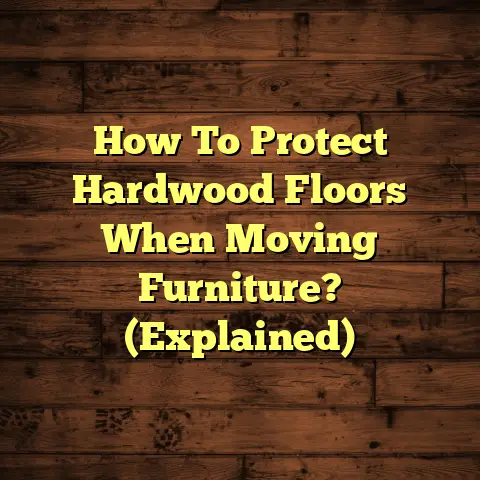Hardwood Floor Gaps Normal? (9 Causes to Check!)
Imagine this: You’re in your living room. Sunlight streams through the windows, highlighting the beautiful wood grain of your hardwood floors.
The kids are playing, laughter fills the air, and the scent of freshly baked cookies wafts from the kitchen.
It’s picture-perfect, right?
But wait… are those gaps between the planks?
Don’t panic!
As a flooring contractor with years of experience, I’ve seen it all.
Gaps in hardwood floors are a common concern, and often, they’re not a sign of impending doom.
In this article, we’ll dive into the reasons why those gaps appear. We’ll also explore what’s normal and what might require professional attention.
Let’s get started!
Understanding Wood as a Natural Material
First things first: wood is a living, breathing material.
Even after it’s milled and installed, it continues to react to its environment.
Think of it like your skin – it expands and contracts with changes in temperature and moisture.
This natural characteristic is the primary reason why gaps form in hardwood floors.
Wood is hygroscopic, meaning it readily absorbs and releases moisture from the air.
When humidity increases, wood absorbs moisture and expands.
Conversely, when humidity decreases, wood releases moisture and shrinks.
Seasonal Changes and Humidity Levels
Ah, the joys of seasonal living! But those beautiful seasons can wreak havoc on your hardwood.
In the winter, when the air is dry (thanks to your furnace), your hardwood floors lose moisture and shrink.
This is when you’ll likely notice those gaps appearing.
In the summer, when humidity is high, the wood absorbs moisture and expands, closing those gaps (or even causing buckling in extreme cases).
Think of it as your floor “breathing” with the seasons.
According to the National Wood Flooring Association (NWFA), maintaining a consistent humidity level in your home is crucial.
I’ve seen homes where the humidity swings wildly from 20% in the winter to 70% in the summer.
This extreme fluctuation is a recipe for gaps (and other flooring problems).
Investing in a good humidifier and dehumidifier can make a world of difference.
Improper Installation Techniques
Okay, let’s talk about installation. This is where things can go wrong fast.
Even the highest-quality wood can develop gaps if it’s not installed correctly.
One of the biggest mistakes I see is inadequate acclimation.
Before installation, hardwood planks need to acclimate to the home’s environment.
This means allowing the wood to sit in the room where it will be installed for several days (or even weeks) to adjust to the temperature and humidity levels.
If you skip this step, the wood will continue to expand or contract after installation, leading to gaps.
Another common mistake is improper spacing.
When installing hardwood, you need to leave a small expansion gap around the perimeter of the room.
This allows the wood to expand without putting pressure on the walls.
If you don’t leave enough space, the wood can buckle or develop gaps in other areas.
I always tell my clients: “Measure twice, cut once… and acclimate, acclimate, acclimate!”
Age and Wear of Flooring
Like a fine wine (or a well-worn leather jacket), hardwood floors develop character with age.
But that character can sometimes include gaps.
Over time, the wood fibers in your flooring can lose their elasticity.
This means they’re less able to return to their original shape after expanding and contracting.
Think of it like an old rubber band that’s lost its stretch.
Also, the finish on your floors can wear down over time, making the wood more susceptible to moisture absorption and damage.
Regular refinishing can help protect your floors and minimize the effects of aging.
I’ve worked on homes with hardwood floors that are over 100 years old.
While they have their share of gaps and imperfections, they also have a unique charm and history that you just can’t replicate with new flooring.
Moisture Issues and Water Damage
Moisture is the enemy of hardwood floors.
Even small leaks or spills can cause significant damage over time.
When wood gets wet, it swells.
If it swells too much, it can buckle or warp.
And when it dries out, it can shrink and leave gaps.
Common sources of moisture problems include:
- Leaky pipes
- Spilled drinks
- Pet accidents
- High humidity
- Poor ventilation
I once had a client who had a slow leak under their kitchen sink for months without realizing it.
By the time they discovered the leak, the hardwood floor was completely ruined.
It had to be replaced.
Regularly inspect your floors for signs of moisture damage, such as discoloration, cupping, or buckling.
And address any leaks or spills immediately.
Subfloor Problems
Your subfloor is the foundation of your hardwood floor.
If it’s not level, stable, and dry, it can cause all sorts of problems, including gaps.
An uneven subfloor can put stress on the hardwood planks, causing them to shift and separate.
A bouncy or squeaky subfloor can also indicate underlying problems, such as rot or water damage.
Before installing hardwood, it’s essential to ensure that your subfloor is in good condition.
This may involve repairing or replacing damaged sections, leveling uneven areas, and ensuring that the subfloor is properly dried.
I always recommend having a professional inspect your subfloor before installing new hardwood floors.
It’s better to address any problems upfront than to deal with them later.
Temperature Fluctuations
Like humidity, temperature fluctuations can also affect hardwood floors.
Extreme temperature changes can cause the wood to expand and contract, leading to gaps.
This is especially common in homes without climate control.
For example, if you turn off your heat while you’re on vacation in the winter, the temperature in your home can drop dramatically.
This can cause the wood to shrink and create gaps.
Similarly, if you don’t use air conditioning in the summer, the temperature in your home can rise significantly, causing the wood to expand.
Maintaining a consistent temperature in your home can help minimize these effects.
I advise my clients to invest in a programmable thermostat to regulate the temperature, even when they’re not home.
Type of Wood and Quality of Planks
Not all hardwood is created equal.
Some types of wood are more stable and less prone to gaps than others.
For example, engineered hardwood is generally more stable than solid hardwood because it’s made up of multiple layers of wood that are glued together.
The quality of the wood planks also matters.
Planks that are poorly milled or have defects are more likely to develop gaps.
I always recommend buying high-quality hardwood from a reputable supplier.
It may cost more upfront, but it will save you money in the long run.
Here’s a quick rundown of some common hardwood species and their relative stability:
| Wood Species | Stability |
|---|---|
| White Oak | High |
| Red Oak | Medium |
| Maple | Medium |
| Hickory | Medium |
| Brazilian Cherry | Low |
Note: Stability refers to the wood’s resistance to expansion and contraction due to changes in humidity and temperature.
Environmental Factors
Finally, let’s talk about environmental factors.
Your geographic location and typical weather conditions can also affect your hardwood floors.
For example, if you live in a humid climate, your floors will be more prone to expansion and contraction.
If you live in an area with extreme temperature fluctuations, your floors will also be more susceptible to gaps.
Coastal areas with salty air can also be hard on hardwood floors.
The salt can corrode the finish and make the wood more brittle.
I always recommend choosing a hardwood species that is well-suited to your local climate.
And be sure to take extra precautions to protect your floors from moisture and temperature fluctuations.
Wrapping Up the Discussion
So, are gaps in hardwood floors normal?
The answer is: it depends.
A few small gaps, especially during the winter months, are usually nothing to worry about.
It’s simply a natural part of the wood’s lifecycle.
However, large or excessive gaps, especially if they’re accompanied by other problems like buckling or cupping, may indicate a more serious issue.
In that case, it’s best to consult with a professional flooring contractor.
Remember, hardwood floors are a beautiful and valuable asset to your home.
With proper care and maintenance, they can last for generations.
By understanding the causes of hardwood floor gaps and taking steps to prevent them, you can ensure that your floors remain beautiful and functional for years to come.
So, embrace the natural beauty of your hardwood floors, gaps and all.
And enjoy the warmth and character they bring to your home.





